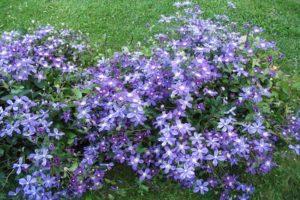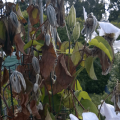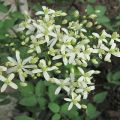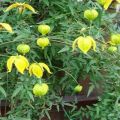Planting dates and care for clematis in Siberia, the best varieties and growing rules
Clematis are loved for their abundant long flowering, decorativeness, pleasant aroma and resistance to the vagaries of the weather. There are several thousand varieties of creepers popular all over the world. The plant thrives equally well in the south and in colder regions. For cultivation in Siberia, clematis are chosen, adapted to the peculiarities of the climate and weather conditions. Consider the best varieties and care rules for the region.
Content
- 1 Description of the species
- 2 Features of the regional climate
- 3 Growing
- 4 Suitable varieties
- 4.1 Elegy
- 4.2 Luther Burbank
- 4.3 Anastasia Anisimova
- 4.4 The president
- 4.5 Multi Blue
- 4.6 Miss Bateman
- 4.7 Cholmondeli
- 4.8 Madame le Cultre
- 4.9 Varshavska Nike
- 4.10 Dr. Ruppel
- 4.11 Nelly Moser
- 4.12 Zhakman
- 4.13 Rouge Cardinal
- 4.14 Huldin
- 4.15 Hegley Hybrid
- 4.16 John Paul 2
- 4.17 Ernest Markham
- 4.18 Purpurea Plena Elegance
- 4.19 Minister
- 4.20 Cosmic melody
- 4.21 Ville de Lyon
- 4.22 Forest opera
- 4.23 Dawn
- 4.24 Climber
- 4.25 Ballerina
- 4.26 Ball of flowers
- 4.27 Golden anniversary
- 4.28 Blue flame
- 4.29 Lilac star
- 4.30 Gray bird
- 4.31 Nikolay Rubtsov
- 4.32 Texa
- 4.33 Blue angel
- 4.34 Koduehe
- 4.35 Lituanica
- 4.36 Niobe
- 4.37 Gypsy Queen
- 4.38 Victoria
- 5 Reproduction
- 6 Protection from pests and diseases
- 7 Use in landscape design
Description of the species
Clematis are representatives of the Buttercup family, another name is clematis. In nature, they grow in the temperate latitudes of the northern hemisphere, in the subtropical zone. Distributed everywhere - on the slopes and shores of reservoirs, in the steppes, shrub thickets.
Perennial plant with liana-like or tree-like shoots. Flowers are solitary, sometimes in inflorescences. Natural species bloom in spring. Flowers have 4-8 petals, many stamens and carpels. About 300 species are known, in Russia - 15. Across the entire Siberian region, the prince, belonging to the subgenus clematis, grows.
Features of the regional climate
Features of the Siberian climate, which are taken into account when choosing a clematis variety for planting:
- low winter temperatures - choose frost-resistant varieties of flowers;
- the possibility of late frosts - the shelter is removed when a steady heat comes;
- early cold snap - late varieties of clematis bloom once in Siberia.
It is better for flower growers to use local planting material purchased from Siberian nurseries.
Growing
The methods of planting and caring for clematis in the Siberian region differ little from the general rules of agricultural cultivation. The main differences are in the abundant pre-winter pruning of the bush, so that it is easier for plants to endure frosts, and in the timely sheltering of flowers.

Variety selection
When selecting varieties, they are guided by frost resistance. Many clematis easily tolerate temperatures down to -30-40 °.The decorativeness of cold-resistant varieties is high, the flowers are large, expressive, bright. When choosing a variety, they take into account on which shoots the flowers of this species develop, because in winter in Siberia, clematis is heavily cut off. According to flowering methods (types of pruning), clematis is divided into 3 groups.
First group
This group of clematis produces buds on last year's old shoots, rarely on new shoots. It is not recommended to grow such varieties in the Siberian region, since in winter the green part of the bush is cut off, and the buds will have nowhere to grow.
The second
Clematis of the second group bloom twice:
- May-June - on last year's branches;
- July-August - on a young growth.

When growing representatives of the second group, strong pruning of the bush is impossible (shoots are shortened by 1 / 3-1 / 4 of the length and insulated with air access). The second group can be planted only in the southern part of Siberia, since weakly covered shoots freeze out in severe frosts. Siberian flower growers still plant these clematis - the most beautiful, terry species belong to this group.
Third
The clematis most adapted to Siberian frosts is the third group, which blooms on vines that have grown on bushes since the beginning of spring. Flowering starts late - July-August. In this class of clematis there are many varieties with exquisite beauty of flowers (there are not many double ones).
Natural varieties
Some wild species have impressive decorative properties, so they are planted in plots. Straight and Tangut clematis grow well in Siberia.

Straight
Dense stems of clematis do not need a garter, the plant resembles a shrub up to one and a half meters high. During the flowering period, the bush is showered with small white buds, the flowers raise their heads to the sun. Abundant flowering - June-July. In winter, the stems are cut at the root.
Tangut
During flowering, clematis is covered with medium-sized yellow bells with drooping heads. More than a hundred buds develop on the shoots. Tangut clematis produces liana-shaped shoots up to 4 meters or grows in a low bush. The plant is also decorated with growing fruits with a long silvery tail.
Landing
In one place, a healthy clematis bush can grow in Siberia for 5-10 years. The longevity of a flower largely depends on the convenience of location and compliance with the planting conditions.

Seat selection
Clematis do not like darkened places where the sun rarely looks. When planting a bush near buildings, choose the southern side, away from the roof, from which water flows. The planting site should be well lit, only light shading is allowed. The greatest danger to plants is stagnant moisture, therefore, in the lowlands, where puddles often stand, as well as in places where groundwater passes high, bushes are not planted.
Choose a place protected from drafts, where excess moisture will quickly evaporate in the sun. Support for clematis is prepared in advance, until the bush has grown.
Important: Clematis grows best on small hills from which water flows. Florists advise to raise the area for a flower - to make a mound 5-15 centimeters high.
Soil requirements
Lomonosov grows poorly on heavy acidified soils with high salinity. Having chosen the soil from the pit, drainage is done - a mixture of broken brick, vermiculite, sand. For deoxidation, lime, dolomite flour, wood ash are added to the soil. When planting a bush, the soil is replaced with a mixture of humus, compost and fertile soil with the addition of complex fertilizers.
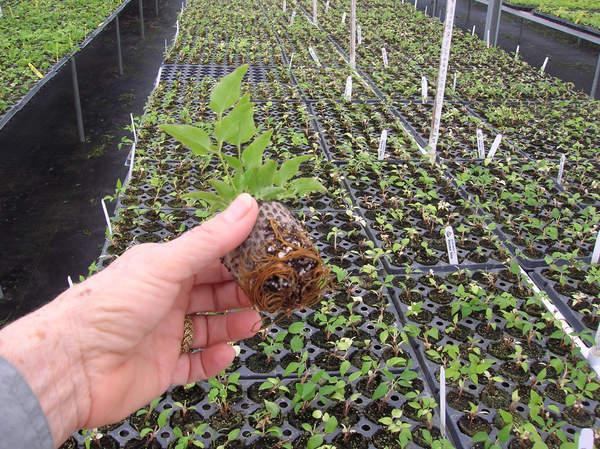
Planting process
Having decided on the site, they dig a hole with sides of 60 centimeters and the same depth. A drainage layer is poured (10-15 centimeters). The roots of the seedling are carefully straightened. Young clematis is placed so that 1-2 buds are buried by 7-12 centimeters. The bush should be placed in a shallow hole, below the soil level.
Landing dates
Most experienced florists advise planting clematis in the spring, although, according to agricultural technology, autumn is also acceptable. It is important to choose a time when the threat of frost passes, but the weather will still be cool and comfortable enough for rooting.
When planting a flower in spring, it is better to prepare a pit in the fall.
Care
Careful care provides long-term abundant flowering and decorative effect of clematis. Care includes watering, garter, fertilizing. Clematis bush grows best when the roots are shaded and cool.

Watering
A strong root system and fast growing vines require a lot of moisture. Clematis bushes are watered abundantly so that the water completely saturates the ground to the lower sections of the roots. Multiplicity - once a week. Water stagnation should not be allowed. After the top layer dries, the soil is loosened to avoid moisture loss, mulched with organic matter, which will serve as a fertilizer for the flower.
Reference: an obligatory part of the care is the removal of weeds, which contribute to the spread of diseases and pests dangerous for clematis, and do not allow excess moisture to leave.
Pruning
During the summer, it is necessary to cut off the drying or diseased parts of the bush, and also, if desired, carry out the decorative formation of the plant. In autumn, with the approach of frost, the branches are cut off, leaving 15-20 centimeters of the stem with 3-4 buds. It is important not to delay pruning the bush before the onset of severe cold weather.
Support construction
Tying the clematis bush, fixing the shoots to the support help to solve the following tasks:
- fix the flower in an upright position;
- ventilate the bush, protect from excess moisture, fungal diseases;
- facilitate maintenance and pruning.
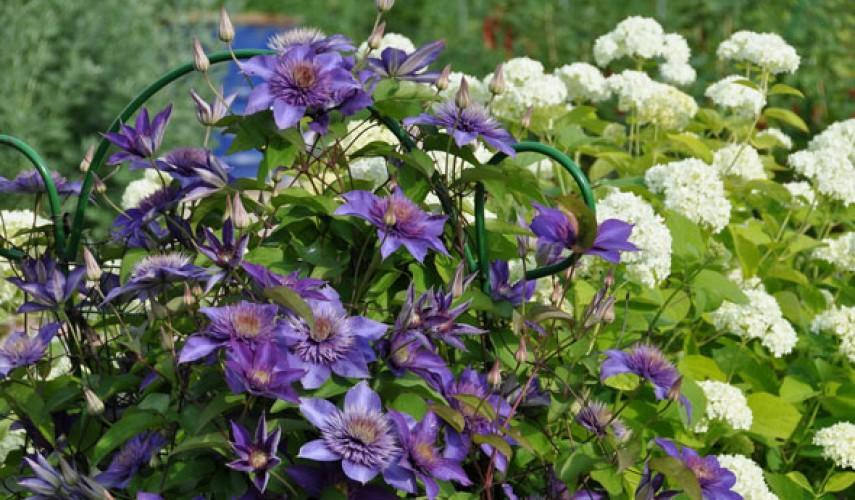
The support performs a decorating function, the flower growers are creative with the construction of the support, because in the absence of greenery, the structure should not spoil the look of the site.
Rolled mesh
Large mesh cells are used to bind clematis shoots planted along the support. Attach the net to strong bars.
Mesh arches
An arched mesh support can be installed on site, creating a resting area. Clematis vines will gradually wrap around the arch, making a natural canopy from the sun.
Obelisks
Supports in the form of obelisks, made of wood, metal rods, firmly hold the clematis, prevent the bush from falling apart.
Picket fence
The remains of the picket fence can be turned into a support for bushes (at least 1.5 meters high).

Arch mesh
Arched structures adorn the site. Having made several symmetrical arches, they stretch the mesh and fasten the shoots.
Tube in the center of the bicycle wheel
A cylindrical support for a bush is constructed from a strong pipe in the center and a bicycle wheel fixed on top.
Wooden grates
You will need a solid frame and lattice in the form of rhombuses or squares measuring 5x5 centimeters. The wood is painted or varnished.
Round support
The spherical support looks great on flower beds, near the terraces. They are made of flexible pipes made of aluminum or plastic; wooden rods serve as an additional support for clematis.
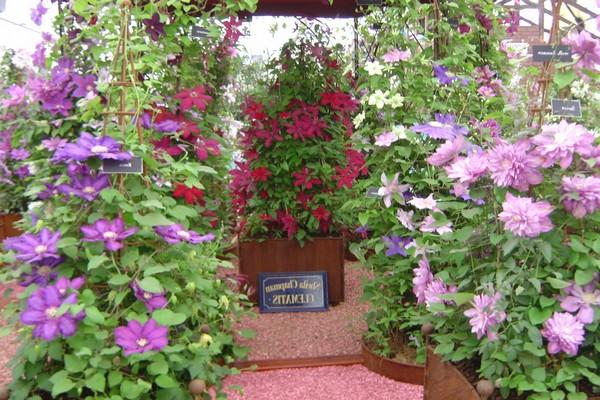
Wooden pergola
A stable, durable and durable wooden pergola can be built from beams and thin slats.
Mesh post
The role of the column is performed by a pipe or fittings. A round or square frame is made on top, the mesh is fixed. Clematis are planted in or around the perimeter.
Pyramids
The clematis planted in different places of the site can be strengthened on stable pyramids made by their slats or pipes.
Semicircle
Semicircular fasteners for the clematis bush are bent from elastic pipes or fittings. It is buried and concreted so that it does not collapse.
Corners on the fence
By reinforcing the clematis corners on the fence, you can create a natural flowering fence around the site.
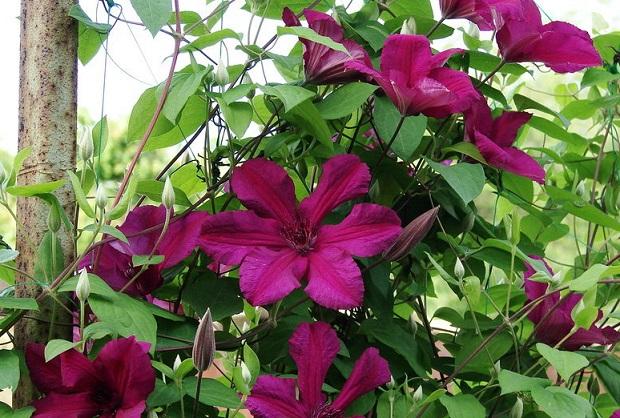
Reference: decorative wattle fences are also used as supports for a flower, trellis-shaped structures, figurines made of reinforcement, clematis are attached to the walls of summer cottages.
Fertilizing and feeding
Only well-fertilized clematis blooms luxuriantly and abundantly. In the spring, the soil in Siberia under the clematis bushes should be deoxidized by adding dolomite flour and lime. Several dressings are carried out during the season:
- nitrogen fertilizers - in the early stages of the growing season;
- potassium - during flowering;
- phosphorus - in the fall.
It is better to use fertilizers containing trace elements - boron, molybdenum, cobalt. Ready-made complexes of prolonged action (Pocon, Kemira) are introduced in the interval between the main dressings.

Shelter for the winter
Even frost-resistant varieties of clematis are covered with the approach of cold weather. Used for winter insulation:
- peat;
- sawdust;
- spruce branches;
- sheets of roofing material or light wooden boards.
Over the shelter, clematis are covered with fallen snow. With the onset of heat, the bush is released, the soil is carefully loosened.

Suitable varieties
Many varieties with frost resistance and high decorative effect are successfully grown in Siberia.
Elegy
Purple beauties with a flower size up to 13 centimeters. Shoots grow up to 3.5 meters. It has been cultivated in Siberia for many years.
Luther Burbank
The Luther Burbank variety is not afraid of frost, blooms all summer months. The flowers are purple-violet with yellow anthers (16-20 centimeters).
Anastasia Anisimova
A strong bush (1-1.5 meters) does not need support, it is strewn with blue flowers with delicate veins.
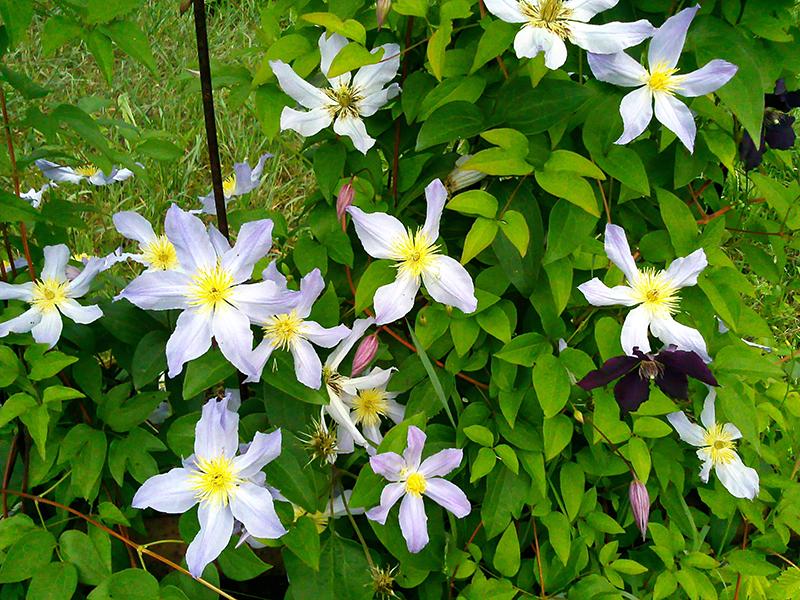
The president
A flower in the shape of a star with wavy petals. Blossoming - twice a season, the color of the flowers can change from dark to light purple.
Multi Blue
Lush double flowers ranging in color from purple to blue and up to 20 centimeters in size. In the absence of early frosts, the bush can bloom again in the fall.
Miss Bateman
White and delicate, like an English miss, flowers grow up to 15-17 centimeters. They are grown in Siberia due to their unpretentiousness and resistance to adverse conditions.
Cholmondeli
Clematis of this variety produce flowers in shades from lilac to lilac. On old shoots - semi-double, on young ones - simple.
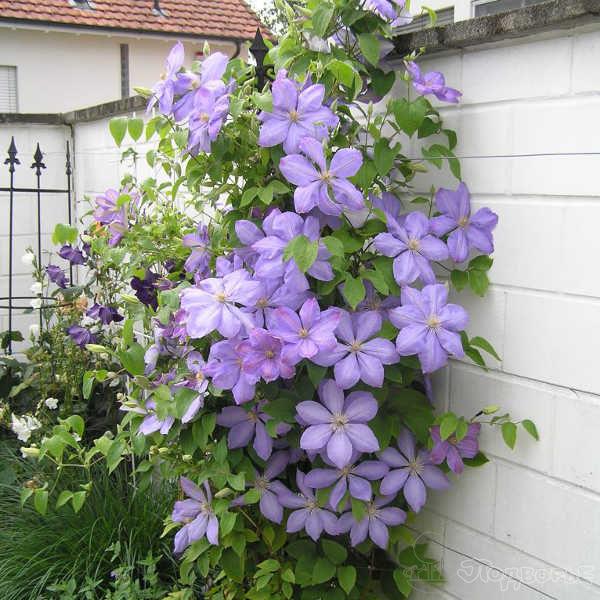
Madame le Cultre
A bush with lily-white flowers withstands frosts down to -35 ° in winter.
Varshavska Nike
The petals, dark purple in the center and lighter towards the edges, do not fade in the sun. Blossom twice.
Dr. Ruppel
Flowers of exquisite shape and color with lush anthers. The petals are pale pink with a brighter stripe in the center.
Nelly Moser
Star-shaped flowers with 6-8 petals with pointed tips. The petals are light pink with a bright purple stripe in the center.

Zhakman
4-6 petals of clematis are colored dark purple with a tendency to discoloration to a bluish tint.
Rouge Cardinal
Velvety bright purple or burgundy flowers will adorn any area. Abundant flowering, June-August.
Huldin
Late variety with large white flowers with a pearly sheen.
Hegley Hybrid
English miracle with heads up to 18 centimeters. The petals are pink-lilac, the anthers are claret-lilac.

John Paul 2
Clematis blooms with snow-white buds with a pale pink unexpressed stripe in the center of the petal.
Ernest Markham
1936 variety. It is famous for its colors of bright shades of red - from pink-purple to red-burgundy.
Purpurea Plena Elegance
Small flowers cover the bush with a purple-violet blanket.
Minister
A pink-purple stripe in the center runs along the bluish lavender petals.
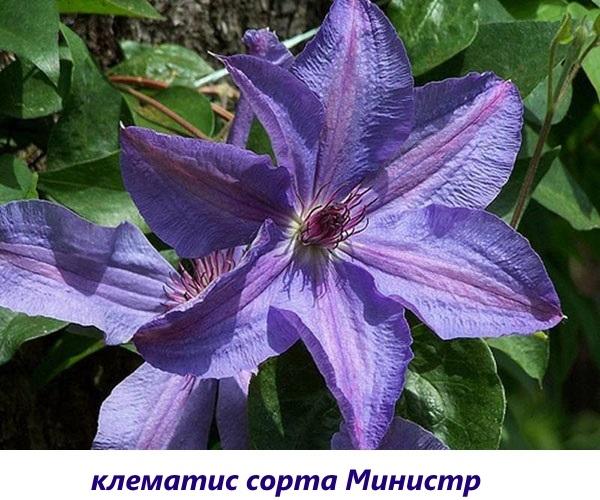
Cosmic melody
The flowers are strongly open, cherry-colored with velvety petals. Abundant and long-lasting flowering.
Ville de Lyon
Pink-red flowers with a pronounced border around the edge.
Forest opera
White petals almost close together, form a circle. Blooms until frost.
Dawn
A rare variety with snow-white flowers, which are pale pink at the beginning of blooming.
Climber
Clematis of the Alpinist variety has light lilac petals of an elongated diamond shape.

Ballerina
In their whiteness and shape, the opened flowers resemble a ballet tutu. Blooms again in August.
Ball of flowers
Rounded petals of clematis are painted in a pale purple color, in the center there is a brighter stripe.
Golden anniversary
Violet-purple pointed petals of clematis gradually brighten in the sun.
Blue flame
One of the most reliable varieties for Siberia with purple petals.

Lilac star
The mauve flowers do not fade in the sun, flowering June-August.
Gray bird
The slightly curved downward and outstretched petals of a violet-blue color give the flowers the appearance of a bird.
Nikolay Rubtsov
Abundant flowering along the entire height of the bush with pink-lilac buds.
Texa
Buds with a complex color of petals - a blue background with a stripe and strokes of pink and white shades.
Blue angel
Clematis blooms in a lush cloud of pale blue flowers.
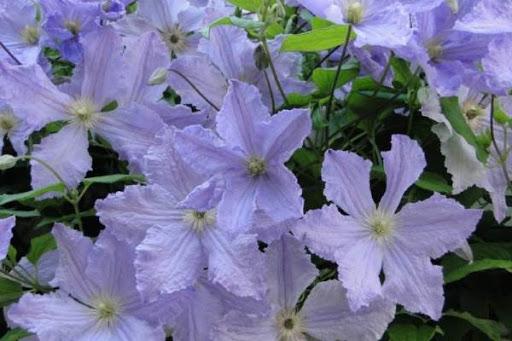
Koduehe
Delicate lilac color of the petals with a darker stripe in the center.
Lituanica
A variety bred by Lithuanian breeders with red anthers, wavy white-pink petals.
Niobe
Highly decorative flower of bright purple color with short yellow anthers.
Gypsy Queen
Purple flowers can fade in the sun; a shaded area is chosen for planting.
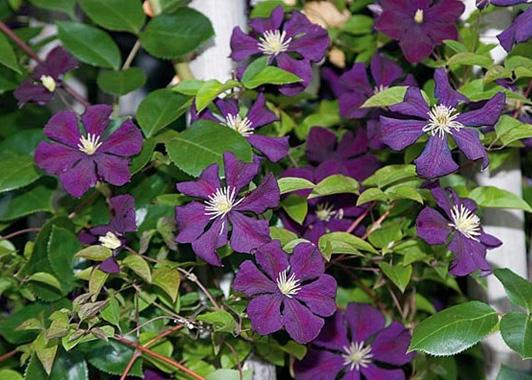
Victoria
Delicate clematis with a purple-pink color and a yellow heart are bred in Estonia.
Reproduction
Clematis owners use several methods of propagation of mother plants. The methods do not require special knowledge, they are not labor-consuming, it is possible to obtain viable clematis that completely repeat the properties of the variety.
Stem layering
The simplest and most effective way to quickly get the desired number of new clematis bushes is to drop the stems down. Several small cuts are made on the shoot, the stem is pinned to the soil with a hairpin and sprinkled with soil. The procedure is carried out in June-July, so that the cuttings give roots before winter.
In winter, the shoots are covered, in the spring the bushes are transplanted to a new place. This method gives good results on fertile, well-fertilized soils.

Green layering
Areas of stems (green or woody) are cut from vegetative bushes, placed in a mixture of sand, peat in small containers. Layers are taken in May-June, kept in greenhouses with a temperature of 18-22 °. Watered every other day, avoiding stagnation of water in containers.
Division of an adult bush
Dividing a bush is an unpredictable process and is rarely used. There is a risk of losing all planting material. A bush at the age of 3-5 years is dug, the rhizome is divided, depending on the size, into 2-3 parts.
Protection from pests and diseases
Cold rainy weather, poor ventilation of the bushes, an incorrectly selected area provoke the development of fungal diseases in clematis. Pests attack bushes in the presence of weeds, planting thickening and lack of treatment.
Wilt
A fungal disease leads to drying out of vines, twisting of leaves, and death of stems. In the spring, before the beginning of the growing season of the bush, the soil is preventively shed with Bordeaux liquid, fungicidal preparations. The infected areas of the bushes are cut out and burned. The bush is treated with Fundazol, a solution of potassium permanganate, and copper sulfate.
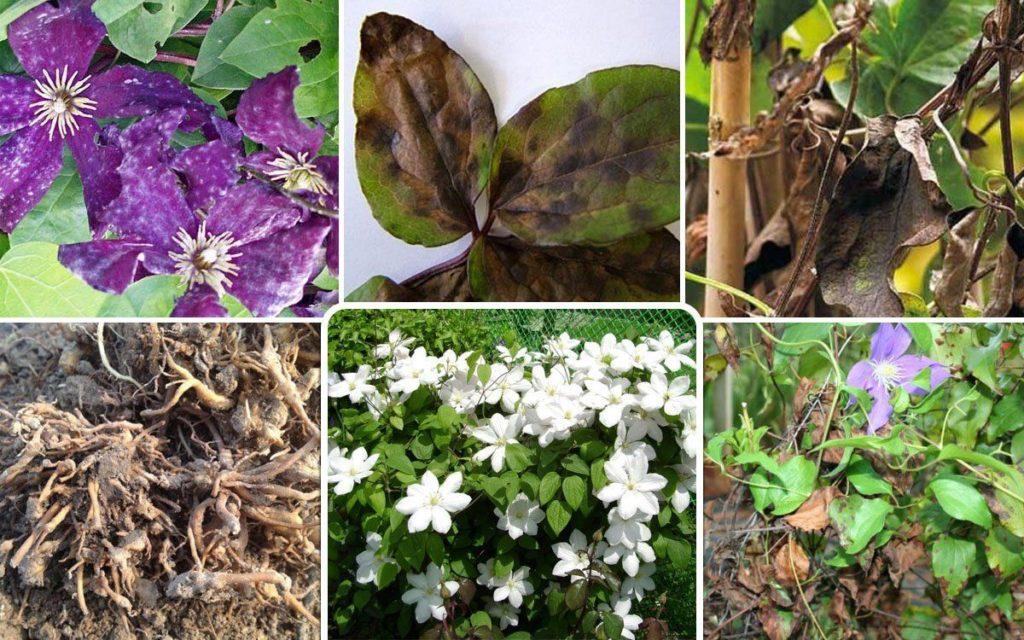
Nematodes
There are several types of nematodes that are equally dangerous for clematis. They affect roots, stems, flowers. For the destruction of nematodes, drugs Nematofagin, Dimethoat are used. In case of severe damage, the bush will have to be dug up and destroyed, not to use the site for clematis for 3-5 years.
Spider mite
Ticks are especially dangerous in hot, dry weather, and clematis are regularly examined for cobwebs and insects. To fight, use Actellik, Akarin or more gentle means - Fitoverm, Bitoxibacillin.
Aphid
Small aphids gather in numerous colonies on growing shoots, ants are carriers. For the fight, folk remedies are used (soap, garlic, wormwood, onion husks), mechanical removal. With a strong infection of the bush - insecticide preparations - Aktara, Iskra.
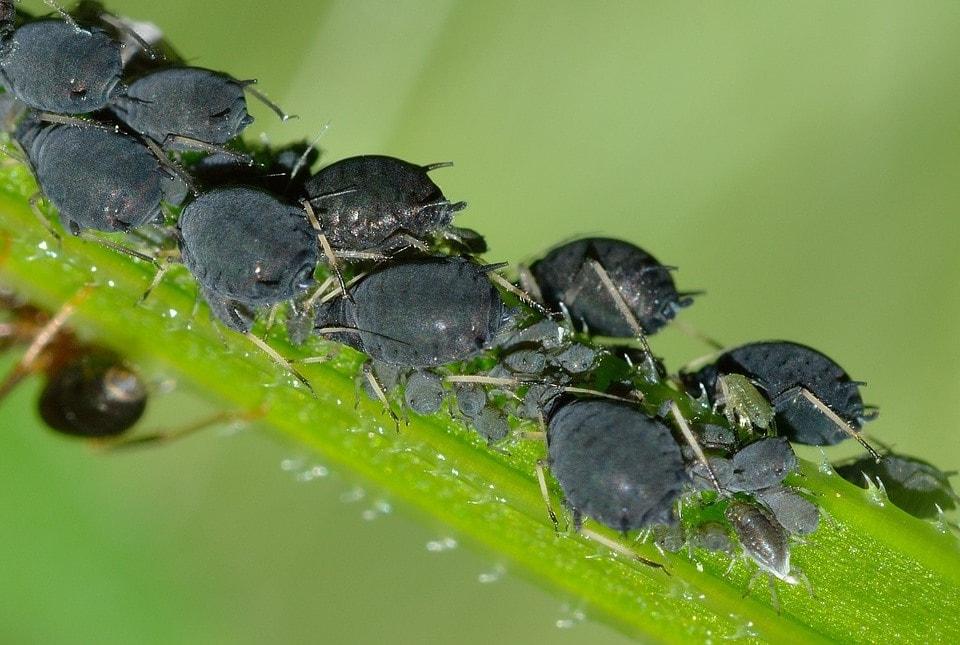
Use in landscape design
Fast-growing clematis with abundant long flowering are used in landscape design in different ways:
- Combined with other plants. The bushes look harmonious and grow together, without interfering with each other, with conifers and roses. Clematis is complemented by other liana-like species - honeysuckle, hops, maiden grapes, lemongrass.
- Clematis of different varieties are planted to create a "blooming wave" - representatives of different species gradually bloom. The site is decorated with blooming clematis in turn throughout the season.
- As a groundcover in rocky and gravel gardens.
- For decorating buildings, gazebos, pillars, dried trees with flowers.
- In containers for decorating verandas, recreation areas with the ability to replace and move flowers if necessary.
- For single planting using decorative supports. The fantasy of flower growers is endless - umbrellas, trellises, arches, obelisks.
Often they combine 2-3 types of clematis in a general composition. When combined, some flowers dominate in size and beauty, while others are smaller, playing the role of a background.
Clematis require regular care and care, they need to be watered, fertilized, tied up, a bush should be formed so that the shoots are placed harmoniously, do not interfere with each other. In response, blooming clematis will give a unique beauty to the site, dissolve a sea of flowers that delight the eye and lift the mood.
